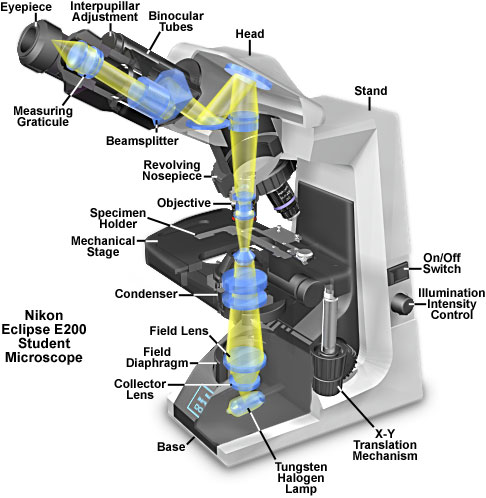Nikon Eclipse E200 Microscope Cutaway Diagram
|
Available since 1999, the Eclipse E200 student microscope is equipped with the CFI60 optical system, which is a combination of Nikon's CF specialty optical glass alloys utilized in objective construction coupled to internal microscope lenses to produce a unique infinity-corrected system. This advanced optical system provides long working distances, high numerical apertures and flat images over the entire field of view with virtually no curvature of field when the field number is 20 millimeters or lower. New dedicated CFI (Chrome-Free Infinity) E Plan Achromat objectives were developed for the E200, but many of Nikon's higher-grade objectives are compatible with this student microscope. A unique innovation, the refocusing stage, eliminates the need to refocus the image manually when dropping the stage to exchange specimens or oil a slide. This stage can be instantly dropped by pushing it down, returning to its original position as soon as it is released. An upper limit stopper allows the stage to be set so that the objective doesn't hit the specimen slide, protecting both from damage. Anti-mold paint plus anti-mold agents sealed at critical places inside the microscope help the E200 resist mold growth in hot and humid work environments. In addition, this model features one-hand operation knobs and handles and an adjustable ergonomic tilt angle eyepiece tube. Up to two eye-level risers can be mounted to raise the height of the eye point in 25 millimeter increments for a total rise of 50 millimeters. The CFI60 infinity optical systems consist of an objective, a tube lens to focus light from the objective, and an eyepiece lens. A parallel optical path exists between the objective and the tube lens, into which modules can be placed in order to create a flexible modern microscope system without additional relay optics. Infinity optics, incorporating parallel light beams, offer an intrinsic design advantage in that they are relatively insensitive to optical components in the telescopic space between the objective and the tube lens. So long as they are plane parallel, infinity optics are not affected by the thickness of components, such as filters, analyzers, compensators, DIC prisms, and reflectors. The location of the image point remains constant, both axially and laterally, as does the alignment between the objective and the tube lens. Contributing Author Michael W. Davidson - National High Magnetic Field Laboratory, 1800 East Paul Dirac Dr., The Florida State University, Tallahassee, Florida, 32310. |
© 1995-2022 by Michael W. Davidson and The Florida State University. All Rights Reserved. No images, graphics, software, scripts, or applets may be reproduced or used in any manner without permission from the copyright holders. Use of this website means you agree to all of the Legal Terms and Conditions set forth by the owners.
This website is maintained by our
|
